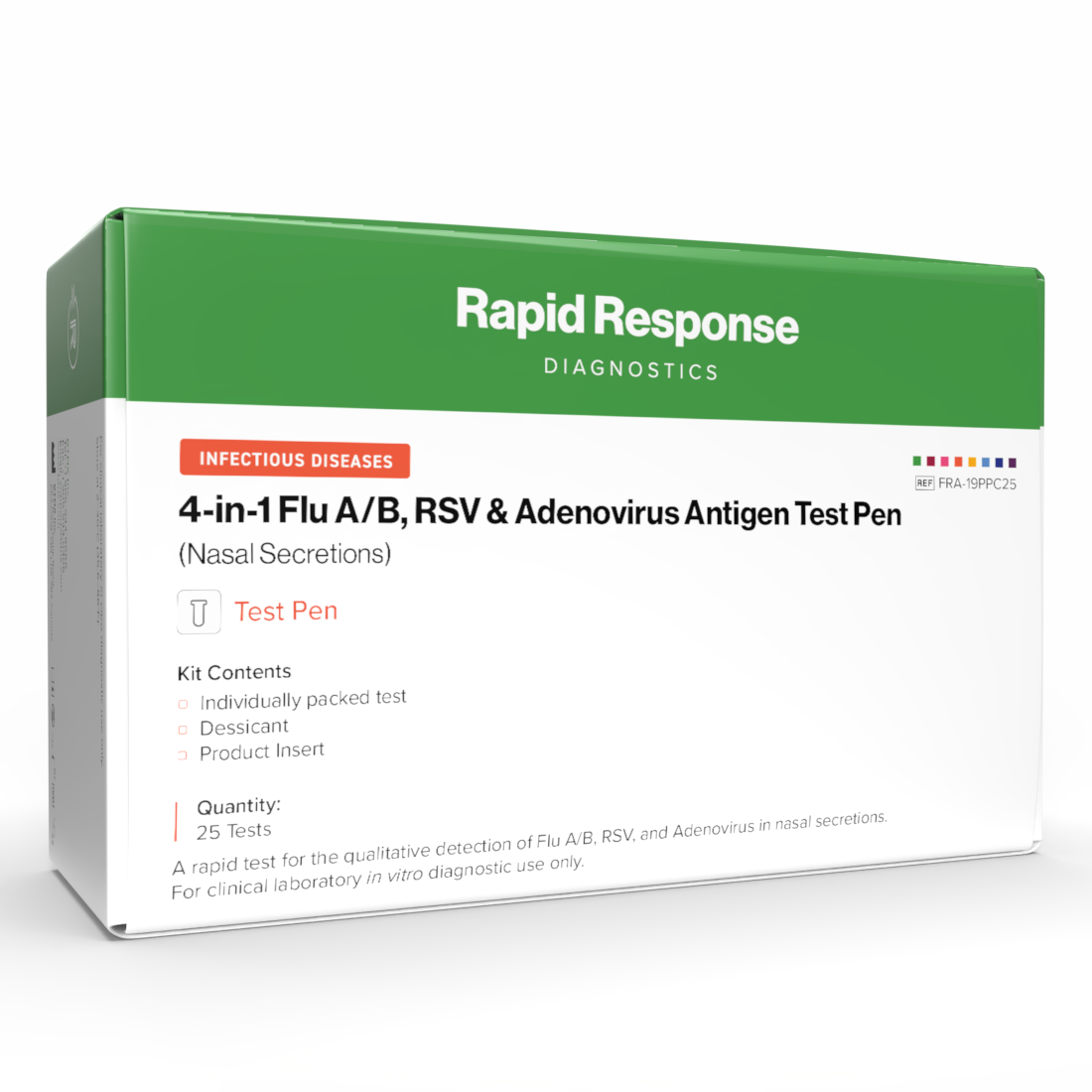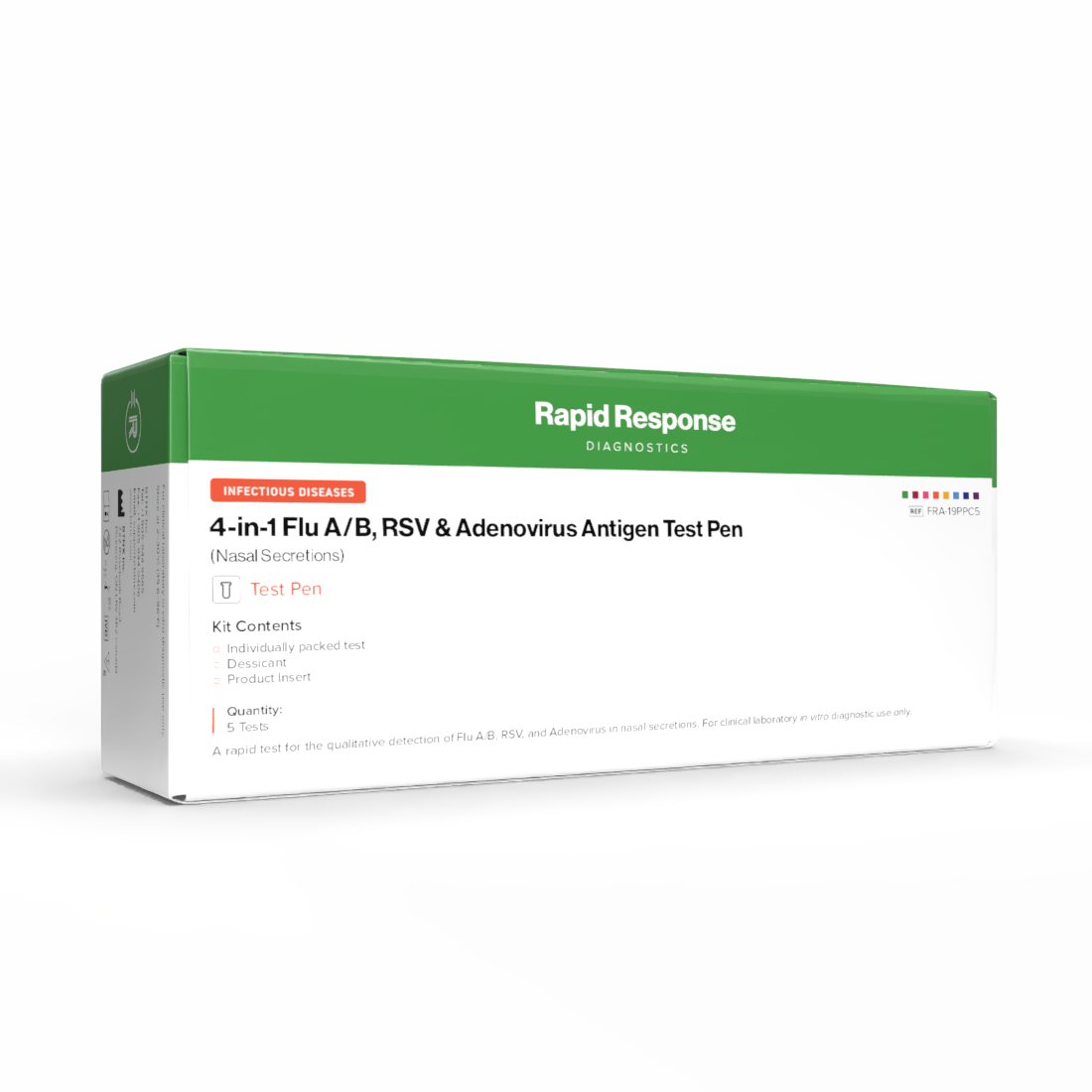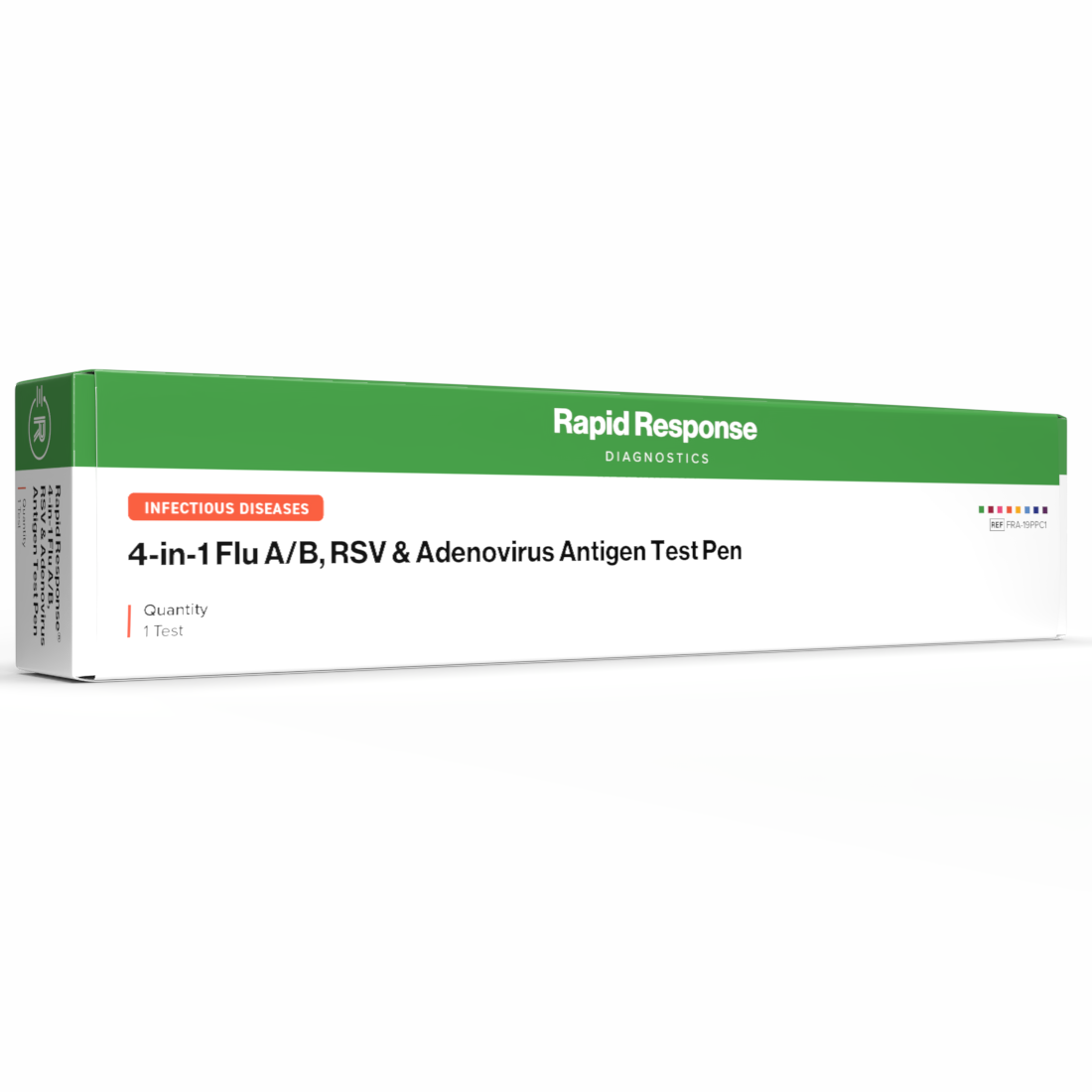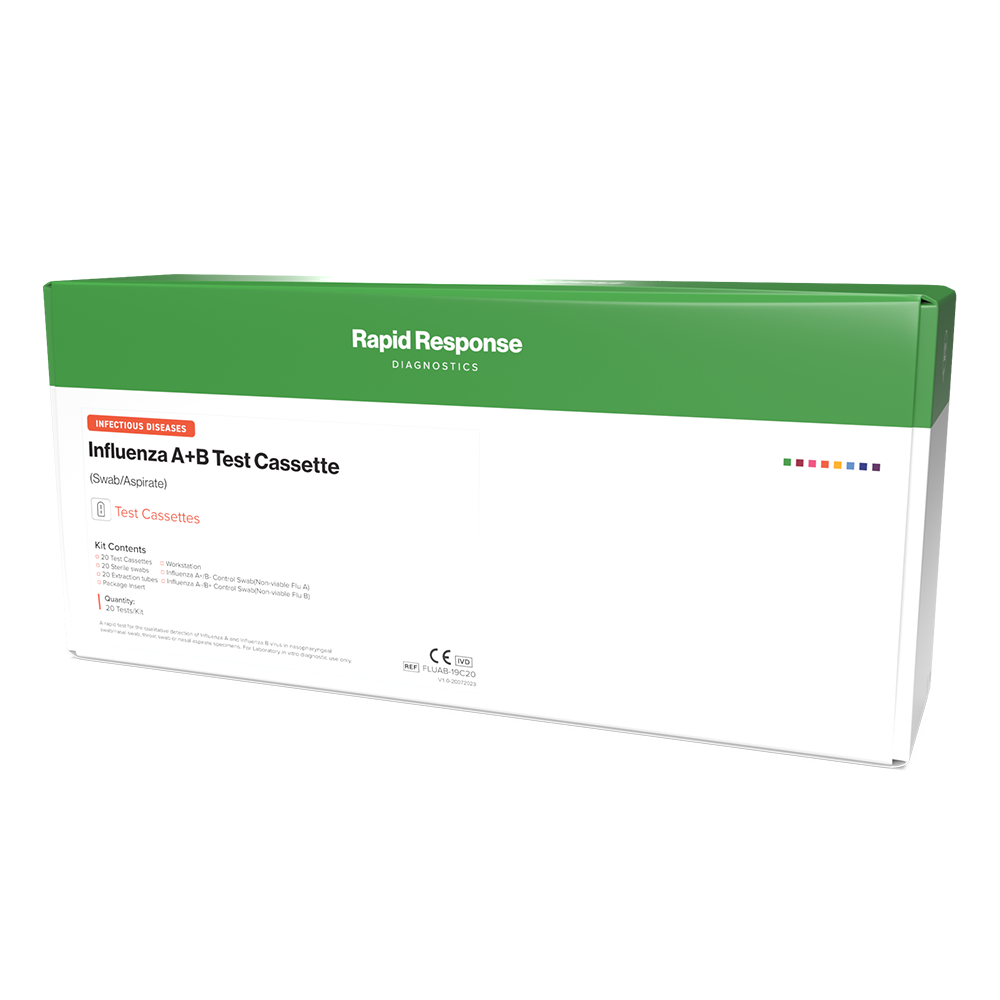Influenza A & B

An infectious disease is an illness caused by specific contact with a pathogenic viruses, bacteria or parasites. Diagnostic tests are vital tools in understanding and controlling its spread. BTNX Inc. offers an array of infectious diseases test kits that are geared to aid healthcare professionals and at home users in efficiently and accurately diagnosing many infectious diseases including COVID-19, RSV, FLU A & B, H. pylori and more!

Format: Pen
Kit Size: 25 Tests / Kit

Format: Pen
Kit Size: 5 Tests / Kit

Format: Pen
Kit Size: 1 Test / Kit

Format: Cassette
Kit Size: 20 Tests/Kit
Introduction to Influenza
What is Influenza?
Influenza (commonly known as ‘flu’) is a highly contagious, acute viral infection that infects the respiratory system including the nose, throat, and sometimes the lungs. Infections caused by the virus can cause mild to severe illness, and sometimes its complications can be deadly.
How does Flu Spread?
Influenza is a communicable disease that is easily spread through airborne droplets, carrying the live virus, when someone with the infection talks, coughs or sneezes1.
When is Flu Season
Seasonal influenza (flu) viruses are detected year-round, but influenza outbreaks typically occur during the fall and winter months. Several other respiratory viruses also spread during the flu season and can cause similar signs and symptoms as the flu.
Influenza Symptoms
After exposure and infection with influenza virus, symptoms usually appear about one to four days. The flu can cause mild to severe illness. Flu symptoms usually appear quickly. Common symptoms include a fever, aching muscles, chills, and sweats. People who have flu may experience some or all of these signs and symptoms of the flu:
- Fever or feeling feverish/chills
- Cough
- Sore throat
- Runny or stuffy nose
- Muscle or body aches
- Headaches
- Fatigue (tiredness)
- Vomiting and diarrhea (more common in children than in adults)
Who is most likely to get sick with the flu?
According to the CID study, children are most likely to get sick from flu and people age 65 and older are least likely to get sick from flu.
Period of contagiousness
You may be contagious beginning on day one before symptoms develop and up to five to seven days after becoming sick. People with flu are most contagious during the first 3 days of their illness. People with weakened immune system and young children may be contagious for longer periods of time.
How to Prevent the Flu
According to the Centers for Disease Control and Prevention (CDC), the best way to prevent seasonal flu is to get a flu vaccine each year. It has shown to help reduce the severity of flu related illnesses and the risk of serious flu complications. CDC also recommends everyday preventative actions to help reduce the spread of germs that cause respiratory illnesses like flu such as distancing from people who are sick, covering coughs and sneezes, frequent handwashing, and taking steps for cleaner air.
Types of Influenza Tests
Viral culture tests: The gold standard of laboratory diagnosis is 14-day cell culture with one of a variety of cell lines that can support the growth of influenza virus2. Cell culture has limited clinical utility, as results are obtained too late in the clinical course for effective patient intervention.
RT-PCR (molecular) tests: Reverse Transcriptase Polymerase Chain Reaction (RT-PCR) is a newer method that is generally more sensitive than culture with improved detection rates over culture of 2-23%3. However, RT-PCR is expensive, complex and must be performed in specialized laboratories.
Rapid, point-of-care (antigen) tests: The qualitatively detects the presence of Influenza A and/or Influenza B antigen in nasopharyngeal swab/nasal swab, throat swab or nasal aspirate specimens, providing results within 8 minutes and the test uses antibodies specific for Influenza A and Influenza B to selectively detect Influenza A and Influenza B antigen.
Some tests also include the ability to test the same sample for COVID-19.
Where to get an Influenza Test
Tests for influenza are often requested from a doctor and conducted in a hospital, healthcare clinic, pharmacy, or laboratory.
When to get tested for the flu
If you are experiencing symptoms of flu, such as fever, aching muscles, chills, and sweats, ask your doctor about requisitioning a Rapid Response Influenza A+B Test Cassette.
Rapid Response Tests
| Product | Details | Features |
|
Rapid Response Influenza AB + COVID-19 Antigen – 3 in 1 Test (SKU: COF-19CPC5, COF-19CPC25) |
Format: Cassette Sample: Nasopharyngeal or anterior nasal swab specimen Time to result: 15 minutes Principle: Lateral Flow Immunoassay Quantity: 5 or 25 Tests/Kit |
|
|
Rapid Response Influenza A+B Test Cassette (SKU: FLUAB-19C20) |
Format: Cassette Sample: Nasopharyngeal swab/nasal swab, throat swab, or nasal aspirate Time to result: 8 minutes Principle: Lateral Flow Immunoassay Quantity: 20 Tests/Kit |
|
COVID-19 vs. Flu
COVID-19 and the Flu have many similarities. Both viruses spread in similar ways such as between people in close contact, through respiratory droplets from talking, sneezing, or coughing. Symptoms in common include fever, cough, sore throat, runny nose, headache, muscle aches, tiredness, and nausea or vomiting (more common in children).
The difference between COVID-19 and the flu is that they are caused by different viruses. COVID-19 and the Flu also spread differently. COVID-19 appears to be contagious for a longer time and spreads more quickly than the flu.
Influenza Tests
Types of Influenza Tests
Viral culture tests: The gold standard of laboratory diagnosis is 14-day cell culture with one of a variety of cell lines that can support the growth of influenza virus2. Cell culture has limited clinical utility, as results are obtained too late in the clinical course for effective patient intervention.
RT-PCR (molecular) tests: Reverse Transcriptase Polymerase Chain Reaction (RT-PCR) is a newer method that is generally more sensitive than culture with improved detection rates over culture of 2-23%3. However, RT-PCR is expensive, complex and must be performed in specialized laboratories.
Rapid, point-of-care (antigen) tests: The qualitatively detects the presence of Influenza A and/or Influenza B antigen in nasopharyngeal swab/nasal swab, throat swab or nasal aspirate specimens, providing results within 8 minutes and the test uses antibodies specific for Influenza A and Influenza B to selectively detect Influenza A and Influenza B antigen.
Some tests also include the ability to test the same sample for COVID-19.
Where to get an Influenza Test
Tests for influenza are often requested from a doctor and conducted in a hospital, healthcare clinic, pharmacy, or laboratory.
When to get tested for the flu
If you are experiencing symptoms of flu, such as fever, aching muscles, chills, and sweats, ask your doctor about requisitioning a Rapid Response Influenza A+B Test Cassette.
Rapid Response Flu Tests
| Product | Details | Features |
|
Rapid Response Influenza AB + COVID-19 Antigen – 3 in 1 Test (SKU: COF-19CPC5, COF-19CPC25) |
Format: Cassette Sample: Nasopharyngeal or anterior nasal swab specimen Time to result: 15 minutes Principle: Lateral Flow Immunoassay Quantity: 5 or 25 Tests/Kit |
|
|
Rapid Response Influenza A+B Test Cassette (SKU: FLUAB-19C20) |
Format: Cassette Sample: Nasopharyngeal swab/nasal swab, throat swab, or nasal aspirate Time to result: 8 minutes Principle: Lateral Flow Immunoassay Quantity: 20 Tests/Kit |
|
References:
- Williams, KM, Jackson MA, Hamilton M. (2002) Rapid Diagnostic Testing for URIs in Children; Impact on Physician Decision Making and Cost. Infec. Med. 19(3): 109-111.
- Betts, R.F. 1995. Influenza virus, p. 1546-1567. In G.L. Mandell, R.G. Douglas, Jr. and J.E. Bennett (ed.), Principle and practice of infectious diseases, 4th ed. Churchill Livingstone, Inc., New York, N.Y.
- WHO recommendations on the use of rapid testing for influenza diagnosis, World Health Organisation, July 2005.
Find the best solution for your needs
Our sales representatives can help set you up for success! Contact our team today!
Influenza (flu) and COVID-19 are both contagious viruses that spreads and infects the respiratory system, but they are caused by different viruses. COVID-19 is a disease caused by a coronavirus named SARS-CoV-2. Flu is caused by infection with influenza viruses.
A diagnostic test can help confirm whether you have flu or COVID-19, or it may be another illness. Talk to a healthcare professional to request a test.
Yes, the Rapid Response Influenza AB + COVID-19 Antigen – 3 in 1 Test aids in the detection and differentiation of COVID-19, influenza A, and influenza B. This test offers optimized care allowing you to test from a single swab sample and determine the appropriate treatment during the same visit. This triple detection method simplifies the testing process, saving valuable time during the busy cold and flu season.
Yes, it is possible to have flu and other respiratory viruses at the same time. It is possible to be sick with multiple flu viruses, such as influenza A and B, at the same time.
Source: Centers for Disease Control and Prevention, National Center for Immunization and Respiratory Diseases (NCIRD)
Most people will recover from the flu and symptoms go away in a few days to less than two weeks. People who have had a flu shot may have symptoms that last a shorter amount of time.
Source: Centers for Disease Control and Prevention, National Center for Immunization and Respiratory Diseases (NCIRD)
Influenza is also known as Flu.
Most often, rest and taking plenty of fluids can help treat the flu. However, severe infection or people at higher risk of complications may need to visit a healthcare professional for prescribed anti-viral medicine to treat the flu. Always refer to your healthcare advisor regarding treatment.
Source: Public Health Agency of Canada

 Canada
Canada